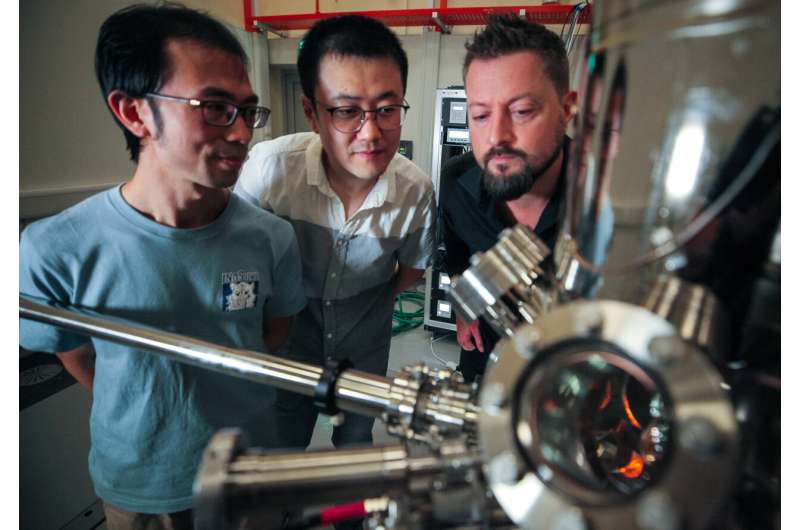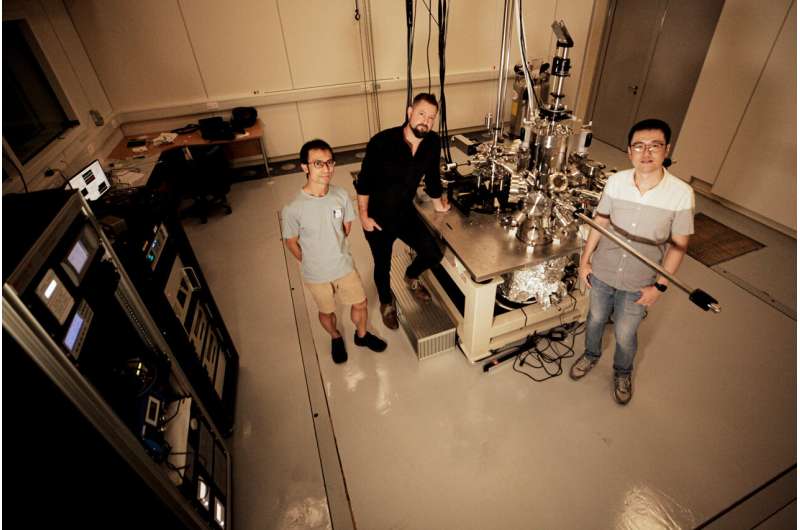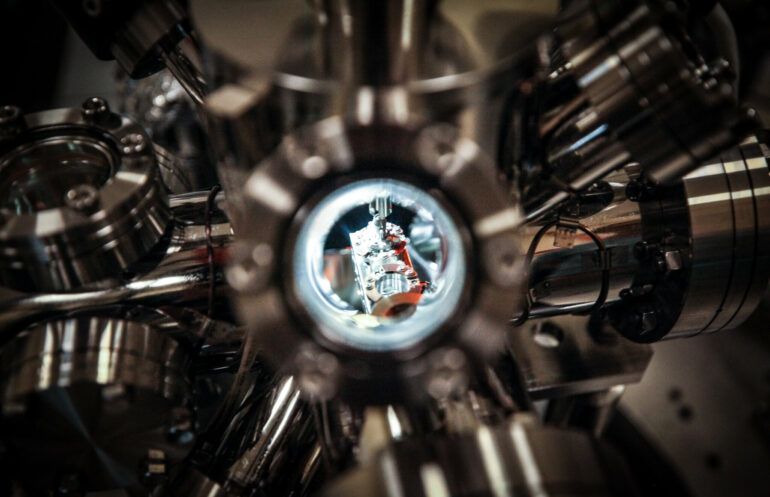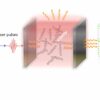Quantum computers, which can perform calculations much faster than traditional computers, have a big problem: They are prone to data storage and processing errors caused by disturbances from the environment like vibrations and radiation from warm objects.
But a discovery by scientists led by Nanyang Technological University, Singapore (NTU Singapore), on how electrons can be controlled at very low temperatures, suggests a way for addressing this problem and developing more robust and accurate quantum computers.
The team’s findings, which were published online in the Nature Communications journal in October 2022, showed, for the first time, that electrons can have strong interactions between them under certain conditions.
These interactions, previously only predicted in theoretical models, were observed on the edges of a type of atomically thin and electrically insulating material at ultra-low temperatures close to the coldness of outer space.
Headed by Assistant Professor Bent Weber from NTU Singapore’s School of Physical and Mathematical Sciences (SPMS), the research team confirmed that interactions at these low temperatures cause the electrons to flow like a liquid. This means that the electrons tend to move collectively along a line instead of moving individually or haphazardly in different directions.

Ripples in an “electronic liquid” that were probed by the atomically sharp tip of a scanning tunnelling microscope in the researchers’ experiments. © SPMS/NTU Singapore
Getting the electrons “in line” for this special state of matter, dubbed a “helical Tomonaga-Luttinger liquid,” is one of the key factors that physicists believe is critical to allowing electrons to group together to form a particle called a parafermion. Besides this special state of matter, another key factor for parafermions to form is needed, which comes into play at even lower temperatures: superconductivity. This property, which refers to the ability to conduct electricity without losing energy, can be found in certain materials.
Creating parafermions is a highly sought-after goal of scientists as these particles are predicted to help quantum computers store information in a more robust way than is possible today.
Quantum computers, which can solve a complex mathematical problem in minutes compared with thousands of years for supercomputers, currently store information by manipulating electrons or light at ultra-low temperatures close to absolute zero or about -273 degrees Celsius.
But the stored data in a quantum computer can be very easily corrupted by disturbances from the environment, including vibrations, radiation from warm objects or changes in electric fields.

(L-R) Dr Que Yande, a senior research fellow from NTU Singapore’s SPMS; PhD student Jia Junxiang, the first author of the study; and Asst Prof Bent Weber from the school who led the research, with a scanning tunnelling microscope at the university. © SPMS/NTU Singapore
Parafermions, however, are believed to be much more resistant to such disturbances because the interactions between the electrons that form a parafermion and the way they move in a material make them more stable. If parafermions were used to store information in quantum computers, the machines should be less prone to errors.
Scanning electrons
In this latest research, the scientists observed how electrons behaved under a scanning tunneling microscope. This was done by bringing the edge of a special class of very thin electrically insulating material incredibly close to the extremely sharp metal tip of the microscope. The distance between the two was just one nanometer or less, even smaller than a strand of DNA.
The insulating material the researchers used comprised microscopic, one atom thick crystals of the compound tungsten ditelluride grown on a graphite or graphene substrate. Such materials, which appear almost two dimensional, are classified as “quantum spin Hall insulators,” which are electrically insulating on the inside but have electrons present along the materials’ edges.

(L-R) Dr Que Yande, a senior research fellow from Nanyang Technological University, Singapore’s School of Physical and Mathematical Sciences (SPMS); Asst Prof Bent Weber from the school who led the research; and PhD student Jia Junxiang, the first author of the study, with a scanning tunnelling microscope at the university. © SPMS/NTU Singapore
The scientists then applied an electric current from the microscope and observed the electrons, while keeping the temperature of the experiment as low as 4.5 Kelvin or about -269 degrees Celsius. This is close to absolute zero, the temperature at which particles slow down so much that they stop moving almost completely.
Usually, electrons repel one another as they are all negatively charged, and tend to behave in a gas-like way, not typically grouping together. But as temperature falls, the electrons’ movements slow down.
At low enough temperatures, strong repulsion between the electrons causes the particles to behave like a liquid.
A measure for the strength of the interactions is a value called the Luttinger parameter. When this parameter is 1, the interactions between the electrons are at their weakest.
“When the Luttinger parameter is less than 0.5, the interactions are strong and the electrons are forced into collective motion. This is the realm where parafermions are predicted to exist,” Asst Prof Weber said.
Using different substrates such as graphene or graphite, and checking different edges of the materials, the researchers were able to determine very low Luttinger parameters which could be controlled within a range of 0.21 to 0.33.
“This is a truly remarkable range of variation, since the Luttinger parameter can only range between 0 and 1,” said Asst. Prof. Weber. “Control of the Luttinger parameter at such low values has never been observed before in any helical Tomonaga-Luttinger liquid.”
Mr. Jia Junxiang, a Ph.D. student from Asst. Prof. Weber’s research group and the first author of the study, said that the experiments were difficult to conduct.
“The scanning tunneling spectroscopy was performed at temperatures of 4.5 Kelvin, and we needed to locate features within less than 30 nanometers (nm),” he said. “The edge of the quantum spin Hall insulator tested was only 2nm thick.”
Probing the surface of materials with the microscope at such distances without losing track of the spot being observed amid changing temperatures is very challenging.
“In the future, one of our biggest challenges will be to move to even lower temperatures, which are needed to observe parafermions. For that, we require much more advanced laboratories and equipment,” said Mr. Jia.
Going forward, Asst. Prof. Weber plans to conduct experiments using such advanced equipment in a new Ultra-Low Vibration Laboratory that was built at NTU Singapore this year. The laboratory will allow experiments to be done at even lower temperatures of 150 millikelvins (mK), which is close to -273 degrees Celsius, where certain materials can become superconducting.
Experimenting on superconducting quantum spin Hall insulators will be the next phase of research his team will embark on in the search for parafermions.
More information:
Junxiang Jia et al, Tuning the many-body interactions in a helical Luttinger liquid, Nature Communications (2022). DOI: 10.1038/s41467-022-33676-0
Provided by
Nanyang Technological University
Citation:
Electrons that flow like liquids pave the way for robust quantum computers (2022, October 25)



